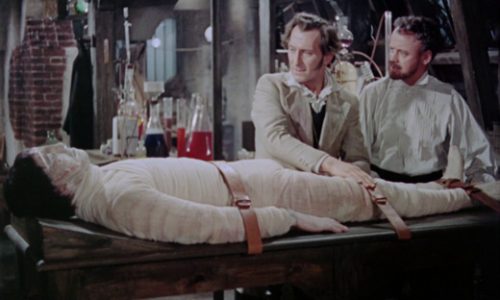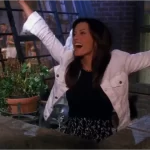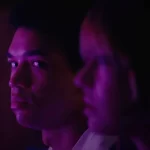Hammer-Rama: The Curse of Frankenstein, by Alexander Miller
Hammer made plenty of great gothic chillers but when you arrive at the Frankenstein and Dracula series, you’re entering the masterclass of their Victorian horror movies. Prior to Dracula, The Mummy, or plagues of zombies, it was an enigmatic Baron and his titular creation that made a small English studio a sensation.
For Hammer, getting the Baron back onto the big screen was a bit of a feat in itself. Milton Subotsky and Max Rosenberg (who would found Hammer’s “rival” studio, Amicus Productions, just a few years after this production) approached Carreras with a Frankenstein script that was more or less a retread of the original James Whale picture. Arousing curiosity from Hammer producer Anthony Hinds, and in-house scribe Jimmy Sangster, who had realized that gothic horror hadn’t been popular in films since the famed Universal series that they too smart to simply ape, but most importantly there hadn’t been a color gothic horror film. The script from Rosenberg and Subotsky would turn into the well-intended but failed TV pilot for The Tales of Frankenstein. Intended to bank off of the success of horror themed shows Thriller, The Twilight Zone, Tales of Frankenstein would be a contentious co-production with Columbia Pictures subsidiary company Screen Gems during the shooting of the following Frankenstein movie. As a standalone Frankenstein story, it’s serviceable, but with the gift of 20/20 hindsight, it feels like a pallid rendition of what could have been the The Curse of Frankenstein.
Front-running director Terence Fisher was assigned the task of directing Sangster’s script, the contents of which had to shy carefully away from anything resembling the Universal film or else they would be sued for infringement. Son of studio founder Anthony Hinds remarked, “We had to make a movie that had to be entirely different from the first one and then it became fun”; some of the most creative moments in films come from restriction and Sangster’s script is a perfect representation of the “artist as a smuggler” motif. The collective talent would brew into the perfect storm, and The Curse of Frankenstein would be the studios quintessential horror title, starting the Hammer Horror phenomenon while catapulting two young actors into superstardom.
Fisher, who at the time had directed some choice episodes of The Adventures of Robin Hood and a few film-noir sci-fi titles for Hammer, helmed their maiden voyage into the high seas of Victorian horror with elegant period atmosphere highlighted by Jack Asher’s (frequently mistaken for Technicolor) lush Eastmancolor cinematography. This was one of the film’s strongest selling points, as it was one of the first British horror films to appear in color, bearing a saturated palette of contrasting greens, yellows and, of course, reds. What might sound like a gimmick is anything but, Fisher made it a point from square one that they were playing this one straight, and that’s why this golden era from Hammer holds up so well.
The Curse of Frankenstein is a $270,000 picture that looks like a multi-million dollar production. James Bernard’s comparatively small orchestra carried abundant frissons of terror by scoring his films to the syllables of the movie title. Simple, effective and a cannily unique trademark to Bernard and Hammer horror., Phil Leakey’s makeup of Frankenstein’s monster was a welcome departure from the flat-top bolt neck image synonymous with Karloff’s monster, again they had to circumvent resembling the Universal film. Fisher’s assured direction with a compelling performance from Peter Cushing painting the Baron as an emphatic sociopath whose quest for scientific advancement is more convincing than the cackling mania of Colin Clive, not so much a sympathetic anti-hero, just a good looking bastard who you can’t help but appreciate. Christopher Lee, who was primarily cast for his height, was originally upset that he had no speaking lines. Cushing reassured him, “Consider yourself lucky. I’ve read the script.” Lee’s handsome features and commanding baritone is buried underneath Phil Leakey’s makeup, which is brilliant in capturing what a re-animated person might look like with the advent of 19th-century surgical equipment; So in other words, a mess.
Despite being silent, Lee lets out a howl when shot in the eye in the film’s more notable scene of gore (by 1957 standards), which wasn’t really acting since the red dye stung his eye so bad. Lee also contributes to the proceedings, saying that he “tried to play the character as an ill-coordinated child” and “the legs should be independent of the arms,” his lumbering bandage-clad man-made creature is an appropriately creepy reinvention of the monster. Lee and Cushing always ignite the screen with their indelible chemistry, the “creator/monster” relation might seem like an odd profile, but the two enigmatic talents own this picture, more so on Cushing’s part, but for better or worse nobody forgets the monster in a Frankenstein movie, in this case, it’s for better. Christopher Lee turned out to be the studio’s most valuable actor after his stately portrayal as Count Dracula the following year, but Peter Cushing’s dedicated physical performances were always more memorable in my opinion. The dedication veered on method, his constant handling of instruments and tools etc. earned him the name “props Peter”, he even consulted with his doctor, asking procedural questions such as “how do you take a brain out?” in this case I can’t fault an actor for their commitment to detail.
Their following Dracula films would be more financially successful but the Frankenstein series proved to be more consistent, with Cushing returning to play the Baron in every official title and Fisher directing four out of the five films.
Thanks to Cushing, Lee and Fisher, The Curse of Frankenstein was a massive success, starting the Hammer horror phenomena as we know it. The international success of this outing established many key fixtures that would make Hammer films standalone specialties in the world of horror, launching one of the studio’s greatest franchises and pairing their two strongest players, who would both become icons in horror cinema.





























